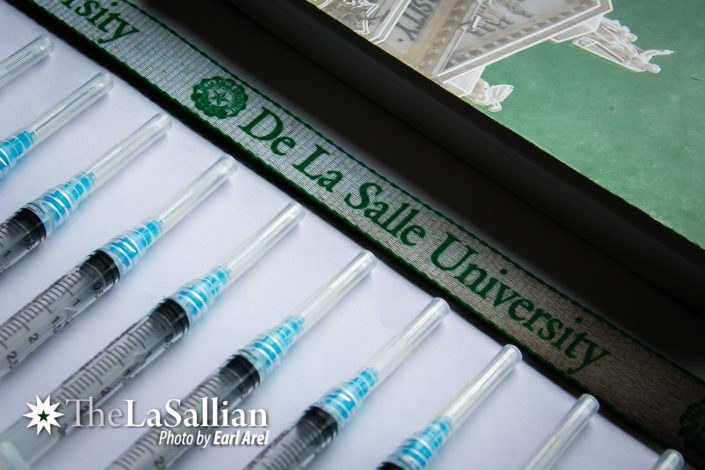DLSU has laid down plans to acquire Moderna’s COVID-19 vaccine together with other institutions under De La Salle Philippines (DLSP) and the International Container Terminal Services Incorporated Foundation (ICTSIF), the corporate social responsibility arm of ICTSI, a developer and acquirer of container ports and terminals. The first batch is expected to arrive within the second quarter of 2021, while the rest of the jabs are targeted to arrive by the fourth quarter.
With the foundation’s aid, the University aims to hold a vaccination program for its teaching and nonteaching staff. Students, however, are not yet covered by these plans.
In an interview with The LaSallian, Vice Chancellor for Administration Dr. Arnel Uy discusses the process of acquiring doses of the vaccine and the prioritization plan that the University will follow.

Priority scheme
Following guidelines set by the World Health Organization (WHO) and the Inter-Agency Task Force on Emerging Infectious Diseases (IATF), the University’s frontliners, specifically its medical and security staff, will receive the highest priority. Succeeding priority tiers will be based on guidelines issued by the IATF, Uy says.
Students, meanwhile, are presently not covered by the University’s vaccination program. “Children are not qualified to be vaccinated. Hence, we cannot involve all the students,” he explains, highlighting that some students might still be minors, who would require additional parental consent before being given a vaccine.
Nevertheless, Uy adds that they are still exploring the possibility of including students in the rollout following guidelines issued by the government.
Sourcing through DLSP, ICTSIF
Prior to being offered by DLSP to join the partnership network with ICTSIF to negotiate with Moderna, DLSU had already begun looking into sourcing vaccines on their own. Led by Supply Chain Management Office Executive Director Cynthia Ruth Abangan, the University approached several pharmaceutical companies to “know their lens for the institutional vaccine acquisition.”
At the time, however, there was no directive from their management regarding the procurement process until the Philippine government crafted rules for tripartite agreements, which permit private sector companies to procure vaccines, provided that they enter into supply agreements with the national government and their choice of pharmaceutical company. Private companies are also expected to spearhead the sourcing up to the delivery of the vaccines.
These guidelines led to invitations from the South Manila Educational Consortium, the Catholic Education Association of the Philippines, and DLSP, to source vaccines. After much deliberation, the University moved to join DLSP’s network in forming a consortium with ICTSIF.
Planning for the community
In preparation for the vaccination plan, the University first had to gauge vaccine acceptability within the Lasallian community. Uy explains that administrators were initially concerned by the results of a fourth-quarter Social Weather Stations (SWS) survey which found that only 32 percent of respondents were willing to get vaccinated against COVID-19.
Using this as their basis, DLSU released its own survey, targeting faculty and non-teaching staff, including support staff. As of March, the survey reached 932 respondents, with 80 percent of them stating that they were willing to avail of the vaccine. The positive response further encouraged the administration to proceed with vaccine procurement.
Along with the survey, the University had also attempted to disseminate information regarding the vaccine through infographics by providing basic information and answering frequently asked questions on the jab. With the materials posted in DLSU’s resource portal, Uy hopes that these will “help the community appreciate the vaccine.”
“We want to communicate to the [Lasallian] community that we are constantly monitoring developments and we are cognizant of certain things but we seek to dialogue with ways moving forward,” he highlights.
Meanwhile, Abangan shares that her office has also done their own research on the vaccine by attending seminars and forums so that the administration would have a more informed decision once the purchase of the vaccine pushes through.
‘Next normal’
While vaccination is a critical tool for curbing the pandemic, it may “not be the savior that will bring [life] back to normal,” Uy supposes, pointing out that even after getting a vaccine, people will still need to wear face masks to meet WHO’s guidelines for fully vaccinated people.
To navigate through a pandemic, he says that one needs to realize that “it’s not just the ‘new normal’ that we are adjusting to,” but there is also an ongoing pivot to what Uy calls the “next normal.”
Uy also notes that the University is gearing for the next normal as it prioritizes initiatives—the vaccine program being one of them—that will help the Lasallian community adjust better. Through these, he hopes to “keep the Lasallian mission alive in the 21st century after the pandemic, or even amid a pandemic,” he remarks.
